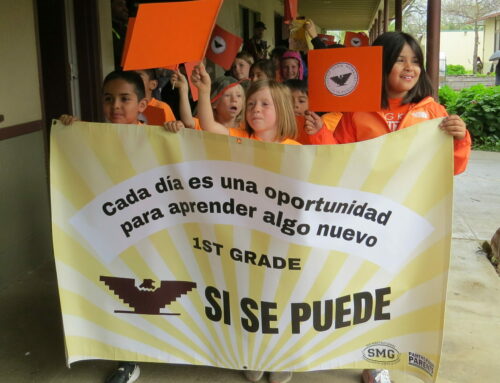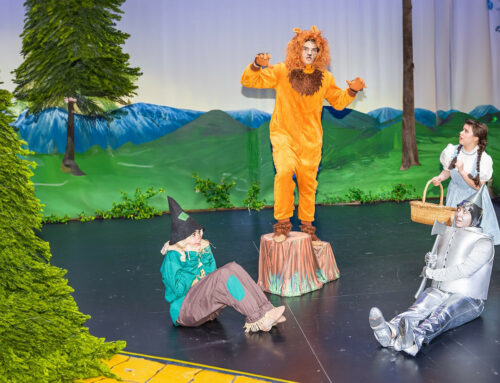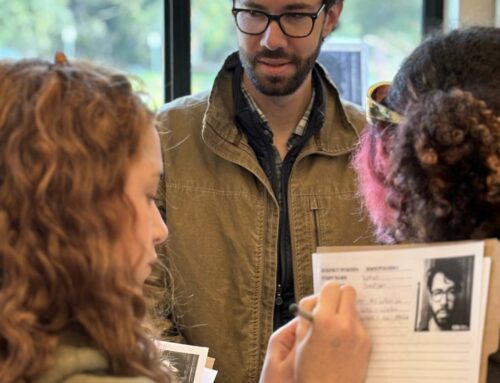Students say outings give them real-world science experience
Published in the May 25 – June 7, 2016 issue of Morgan Hill Life

Photo by Marty Cheek
Live Oak High School students explored the Pinnacles National Park recently, earning dual college credits.
By Nicole Chambers and Josilyn Layton
Live Oak High School this school year served as a novel experiment in science learning. Students in Susan Paulsen’s honors Geology 201 class earned dual-college credit with CSU Bakersfield while learning about rocks, earthquakes and the hydrologic cycle and taking class field trips to sites such as Harvey Bear Ranch County Park and Pinnacles National Park.
“In this class, the students are covering a semester of geology at the university for an entire (high school) year,” Paulsen said. “But what makes it better is that, unlike high school, field trips are mandatory. So it makes you go out into the field and experience it as you will when you get to college.”
The length of the course is 40 weeks — or two high school semesters — as opposed to a length of one quarter at California State University at Bakersfield. The CSUB geology department regularly visits the classroom to oversee the content of the curriculum. Students take field trips to regional parks, the Elkhorn Slough in Moss Landing and the California Academy of Sciences in San Francisco. Funding for the required field trips comes from a $13,600 MH i-Grant Award.

Live Oak High School students explore Pinnacle National Park as part of a geology class where they earn college credits.
Photo by Marty Cheek
“There’s more to science than just being in a classroom. You have to go out and experience and see what it looks like,” Paulsen said. “I love teaching this class. Finally, I have a class interactive with field work, which is what science should be.”
Paulsen’s interaction with students gives them a preview of what college courses will be like, said Madison Blazzard, a Live Oak senior who will be attending Chico State University in the fall.
“I like how Ms. Paulsen treats us like adults. She talks to us about issues that go on in our classroom and our school and our community and the world,” she said, “I think it’s awesome that we have a teacher who helps us understand the world as grown-ups, not just dumbing it down for us.”
The classwork, which includes watching videos and lab projects, prepares the students for the experience they will gain from the geology field trips, she said. One of her favorite trips was the Elkhorn Slough where the students kayaked three miles while learning about the natural environment and the water ecology.
“I don’t know about anyone else but I had no idea until I went there that that really existed. Learning about it was one thing as we got to read about it and look at pictures and watch videos. But to actually go there — wow, that is what my world is like,” she said.
Jose Guerra, a sophomore, said he had no knowledge of geology prior to taking the course but learned to appreciate the natural world. He enjoyed the trips the most as they presented a new way to learn science. “It gets you outdoors and it teaches a little bit more about geology by seeing things,” he said.
Students are challenged more because it’s a college-level course, but it’s given him a better understanding of what college is like in terms of the expectations of students and their learning levels. “There are some ups and downs and there’s some hard parts and some easy parts.”
Mackenzie Mitchell, a senior who will be attending the Fashion Institute of Design and Merchandising in Los Angeles in the fall, said she took the class as a challenge to learn science from a geological perspective.
“I chose this class because I wanted more science credits but it was an honors class which appealed to me because I got the grade bump, but I would also learn more,” she said. “I did it for the learning.”
Like many of her fellow classmates, her favorite part of the class are the field trips, she said.
“The field trips and the projects are very hands on which makes the projects part very interesting,” she said. “And we get to go to interesting places like the Pinnacles National Park. It’s really fun. I’ve enjoyed learning about California and all the fault lines and where I live.”
Alex Holmstrom, a senior who will be majoring in physics at Cal Poly, said going on field trips adds to his appreciation of geology. “It definitely adds a real world knowledge to the class and I think it adds an element you really can’t get in the classroom,” he said.
He described how it’s a very broad class that includes chemistry, physics, and a little bit of everything else, he said.
“Having already taken physics, it gives me a good start in geology because there’s some sections where I can just breeze right through because I already knew it from before,” he said.
A survey taken by 24 students in Paulsen’s Honors Geology Class shows that about 71 percent would consider taking an AP course based on the experience they had in the class. While about 8.3 percent would not consider taking an AP course and 20.8 percent did not provide a response.
Paulsen is passionate about sharing her geology knowledge and seeing how it reflects in students’ excitement during field trips.
“I love to hear all of the students’ ‘woos,’ ‘ahs,’ ‘wow,’ ‘ohs,’ ‘yah.’ I like that part,” she said. “I’m internally worried and stressed out and watching the students every second all of the time. But I can’t hound them. How are they going to learn if they don’t actually go out and try? I tell the students, ‘Failure is learning.’ So if they trip and stub their toe, they’re going to think about where their eyes are next time. But I’ll make sure they don’t fall off the cliff.”
Nicole Chambers and Josilyn Layton are sophomore students in Susan Paulsen’s Geology 201 class. They wrote this story for Morgan Hill Life.









